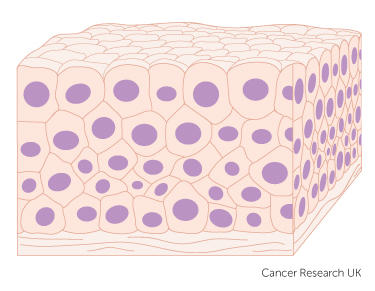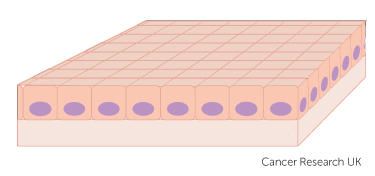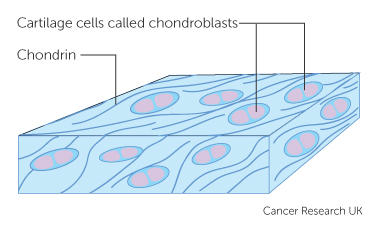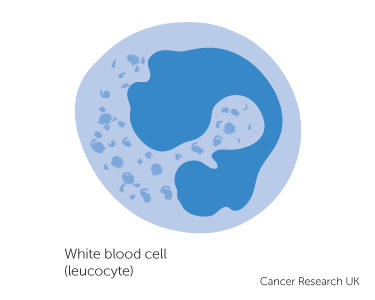TYPES OF CANCER
The main types of cancer
Our bodies are made up of billions of cells. The cells are so small that we can only see them under a microscope.
Cells group together to make up the tissues and organs of our bodies. They are very similar. But vary in some ways because body organs do very different things. For example, nerves and muscles do different things, so the cells have different structures.
There are more than 200 types of cancer and we can classify cancers according to where they start in the body, such as breast cancer or lung cancer.
We can also group cancer according to the type of cell they start in. There are 5 main groups. These are:
- carcinoma – this cancer begins in the skin or in tissues that line or cover internal organs. There are different subtypes, including adenocarcinoma, basal cell carcinoma, squamous cell carcinoma and transitional cell carcinoma
- sarcoma – this cancer begins in the connective or supportive tissues such as bone, cartilage, fat, muscle or blood vessels
- leukaemia – this is cancer of the white blood cells. It starts in the tissues that make blood cells such as the bone marrow.
- lymphoma and myeloma – these cancers begin in the cells of the immune system

- brain and spinal cord cancers – these are known as central nervous system cancers
Carcinomas
Carcinomas start in epithelial tissues. These tissues:
- cover the outside of the body such as the skin
- cover and line all the organs inside the body such as the organs of the digestive system

- line the body cavities such as the inside of the chest cavity and the abdominal cavity.

- Carcinomas are the most common type of cancer. They make up about 85 out of every 100 cancers (85%) in the UK.There are different types of epithelial cells and these can develop into different types of carcinoma. These include:
- squamous cell carcinoma
- adenocarcinoma
- transitional cell carcinoma
- basal cell carcinoma
Squamous cell carcinoma
Squamous cell carcinoma starts in squamous cells. These are the flat, surface covering cells found in areas such as the skin or the lining of the throat or food pipe (oesophagus).

-
Adenocarcinoma
Adenocarcinomas start in glandular cells called adenomatous cells. Glandular cells produce fluids to keep tissues moist.

Transitional cell carcinoma
Transitional cells are cells that can stretch as an organ expands. They make up tissues called transitional epithelium. An example is the lining of the bladder. Cancers that start in these cells are called transitional cell carcinoma.

Basal cell carcinoma
Basal cells line the deepest layer of skin cells. Cancers that start in these cells are called basal cell carcinomas.

Sarcomas
Sarcomas start in connective tissues. These are the supporting tissues of the body. Connective tissues include the bones, cartilage, tendons and fibrous tissue that support organs.
Sarcomas are much less common than carcinomas. There are 2 main types:
- bone sarcomas (osteosarcoma)
- soft tissue sarcomas
These make up less than 1 in every 100 cancers (1%) diagnosed every year.
Bone sarcomas
Sarcomas of bone start from bone cells.

You can read about bone cancers.
Soft tissue sarcomas
Soft tissue sarcomas are rare but the most common types start in cartilage or muscle.
Cartilage
Cancer of the cartilage is called chondrosarcoma.

Muscle
Cancer of muscle cells is called rhabdomyosarcoma or leiomyosarcoma.

You can find out more about soft tissue sarcomas.
Leukaemias – cancers of blood cells
Leukaemia is cancer of the white blood cells. The bone marrow
 makes too many white blood cells. The blood cells are not fully formed and so they don’t work properly. The abnormal cells build up in the blood.
makes too many white blood cells. The blood cells are not fully formed and so they don’t work properly. The abnormal cells build up in the blood.
Leukaemias are uncommon. They make up only 3 out of 100 of all cancer cases (3%). But they are the most common type of cancer in children.
Go to our information about the different types of leukaemia.
Lymphomas and myeloma
Other types of cancer are lymphomas and myeloma, They are cancers of the lymphatic system
 . The lymphatic system is a system of tubes and glands in the body that filters body fluid and fights infection.
. The lymphatic system is a system of tubes and glands in the body that filters body fluid and fights infection.You can read more about the lymphatic system and how cancer may affect it.
Lymphomas
Lymphoma is cancer that starts in the lymph glands or other organs of the lymphatic system.
 The lymphatic system runs all through the body so lymphoma can start just about anywhere.
The lymphatic system runs all through the body so lymphoma can start just about anywhere.It happens because some of the lymphatic system white blood cells (lymphocytes) start to divide in an abnormal way. And don’t die as they should. These cells start to divide before they become fully grown (mature) so they can’t fight infection.

The abnormal lymphocytes start to collect in the lymph nodes or other places such as the bone marrow or spleen. They can then grow into tumours.
Lymphomas make up about 5 out of every 100 cancer cases (5%) in the UK.
You can find out about lymphomas.
Myeloma
Myeloma is a cancer that starts in plasma cells. Plasma cells are a type of white blood cell made in the bone marrow. They produce antibodies, also called immunoglobulins, to help fight infection.

Plasma cells can become abnormal and multiply out of control. They make a type of antibody that doesn’t work properly to fight infection.
Myeloma makes up about 1 out of every 100 cases of cancer (1%) in the UK.
You can find out more about myeloma.
Brain and spinal cord cancers
Cancer can start in the cells of the brain or spinal cord. The brain controls the body by sending electrical messages along nerve fibres. The fibres run out of the brain and join together to make the spinal cord, which also takes messages from the body to the brain.
The brain and spinal cord form the central nervous system. The brain is made up of billions of nerve cells called neurones. It also contains special connective tissue cells called glial cells that support the nerve cells.
The most common type of brain tumour develops from glial cells. It is called glioma. Some tumours that start in the brain or spinal cord are non cancerous (benign) and grow very slowly. Others are cancerous and tend to grow and spread.

Brain and spinal cord tumours make up about 3 out of every 100 cases of cancer (3%) in the UK.
LEUKEMIA
.Fever .Weakness .Fatigue .Petechiae & ecchymosis
.Gum bleeding .Epistaxis (nose bleeding) .Gum hypertrophy
.Bone pain .Lymphadenopathy .Hepato-spleenomegaly.
LYMPHOMA
.Lymphadenopathy .Fever .weight loss .Night sweats
.Difficulty breathing/ chest pain .Itchy skin .Splenomegaly
MYELOMA
.Bone pain .Weakness, malaise .Renal failure .Infection
.Confusion .Excessive thirst .Neuropathies
. Idiopathic (cause unknown)
. Other risk factors:
. Environmental factors . Chemical exposure (e.g. benzene)
. Pesticides exposure . Radiation exposure
. Change in diet habits
. Certain Genetic disorders (e.g. Down’s syndrome)
. Secondary to certain chemotherapy or radiotherapy
LEUKEMIA
.CBC .Peripheral Blood Smear .Bone marrow aspiration & biopsy
.Immunophenotyping .Karyotyping/Cytogenetics
LYMPHOMA
.Excisional lymphnode biopsy .IHC evaluation of the biopsy block
MYELOMA
.CBC, RFT, Calcium, β2 microglobin
.Bone marrow aspiration & biopsy .24 hour Urine protein .Skeletal survey
.Serum Protein Electrophoresis/Serum immunofixation
.Urine Protein Electrophoresis/urine immunofixation
.Free light chain assay
Featured Doctors
Dr. Murari Man Shrestha
Deputy Director Preventive Oncology Division

